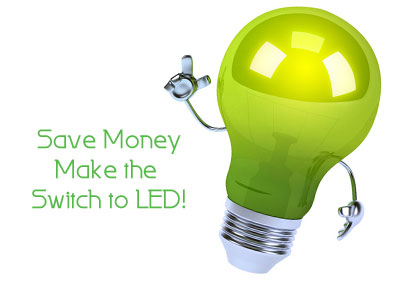LED Lights – Money saving solution for your home
 Today, the focus for just about everyone is saving money in the world that is decidedly more and more expensive. One of the easiest and most effective ways of saving money, especially in the home is by switching to more energy efficient, LED lights. On average, through just changing out one LED bulb, a homeowner can enjoy a savings of more than $80 per year.
Today, the focus for just about everyone is saving money in the world that is decidedly more and more expensive. One of the easiest and most effective ways of saving money, especially in the home is by switching to more energy efficient, LED lights. On average, through just changing out one LED bulb, a homeowner can enjoy a savings of more than $80 per year.
The reason for this is that LED light bulbs use 75 – 90% less energy in the home than an equivalent incandescent bulb. For most homeowners, it is the lighting within the home that makes up approximately 25% of a utility bill. While the initial cash investment for LED bulbs can be significantly more than either compact fluorescent bulbs, the savings are much more because they consume less energy and are replaced far less often.
The term LED is an acronym which comes from, “Light Emitting Diode”. The bulbs fit into circuits that cause them to burn efficiently and at low temperatures. Most of the energy inefficiency of incandescent bulbs was from the heat that they tended to generate. This problem is eliminated with LED bulbs that burn using a unit of measurement known as lumens rather than watts. There are no UV emissions from LED bulbs and there is less of a carbon footprint made when less energy is used throughout the home.
When you purchase LED bulbs, it can be a bit overwhelming in the many different choices that are available. Most lighting uses in the home are for 60 -100 watt bulb level illuminations. This is to prevent those lamps and appliances from overheating and creating a fire hazard. A good rule of thumb when converting from incandescent to LED bulbs is between 800 lumens for a 60 Watt bulb, 900 -1200 lumens for a 75 watt bulb and 1800 lumens for a 100 watt bulb.
When purchasing LED bulbs, be sure to look for Energy Star Bulbs. Energy Star was started by the federal Environmental Protection Agency (EPA) for companies to offer more energy efficient and lower cost options to consumers to help them save money. Nearly all appliances, devices and even light bulbs now feature the energy star symbol.
You can avoid some of the sticker shock of the initial investment in LED bulbs by starting small by replacing bulbs a few at a time in the home. Even the small changes can add up to big savings on your energy bill. Just change out one lamp or two, and then possibly include battery operated lights such as flameless candles or wireless closet lighting and solar powered LED lights to give more light to the home with more energy efficiency.
Later, you might want to consider also including ways to insure the safety of all of the inhabitants, such as installing LED emergency lights that come on whenever the system senses that power to the home has been lost. These lights, whenever an electrical current is not present, will then automatically sense this absence of power and will send out a wireless signal within the home to light up stairways, corridors, exits and to other areas so that they can be well lit enough to keep the people inside safe and secure until power is turned back on again. So employing LED lights for the home can not only be good for the environment by reducing the overall carbon footprint, there is more efficiency and securityadded to the home.
All together, these ways can add more light, security and safety to your home along with energy efficiency.
Category: Save Energy





